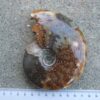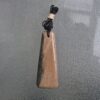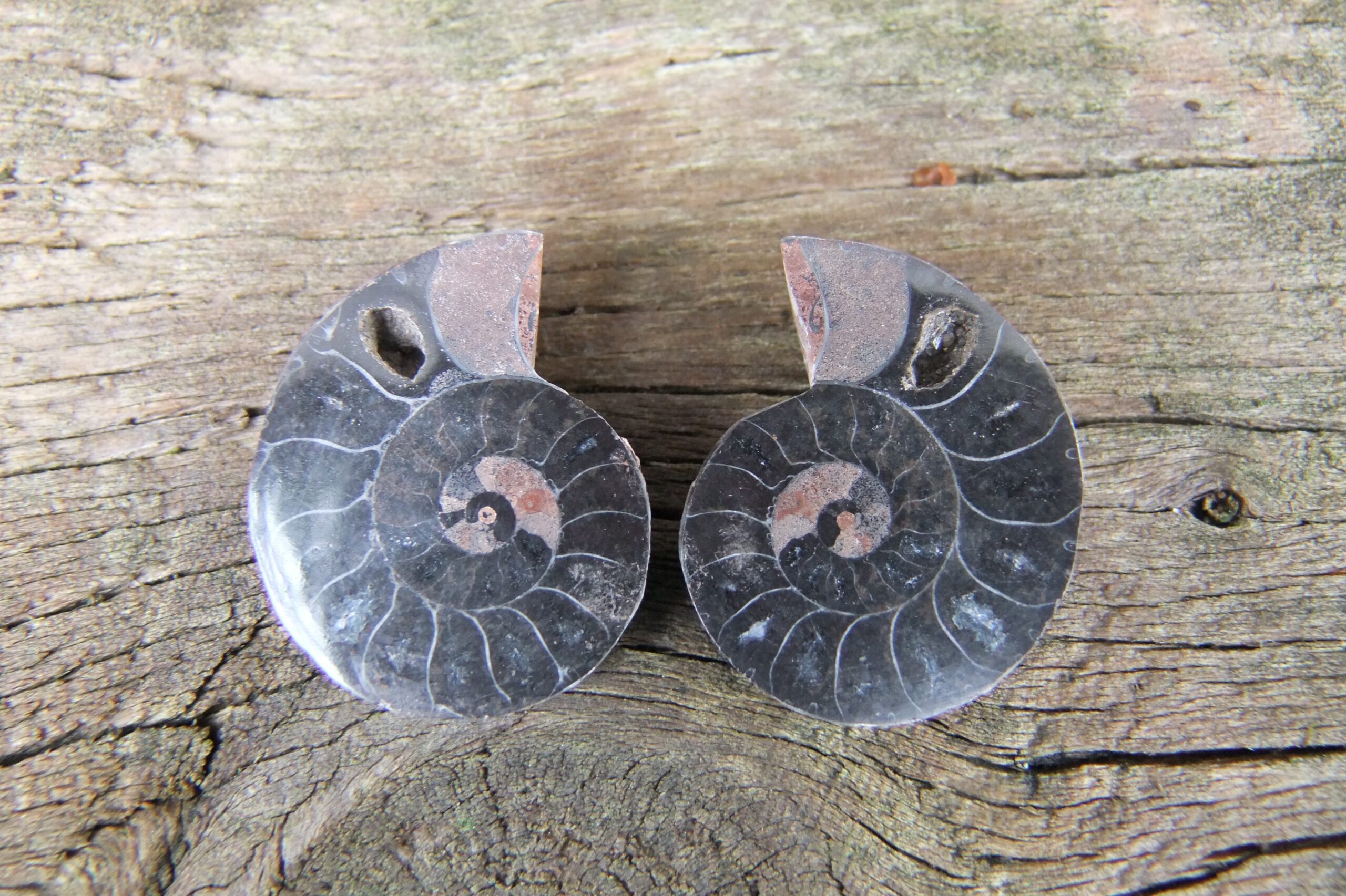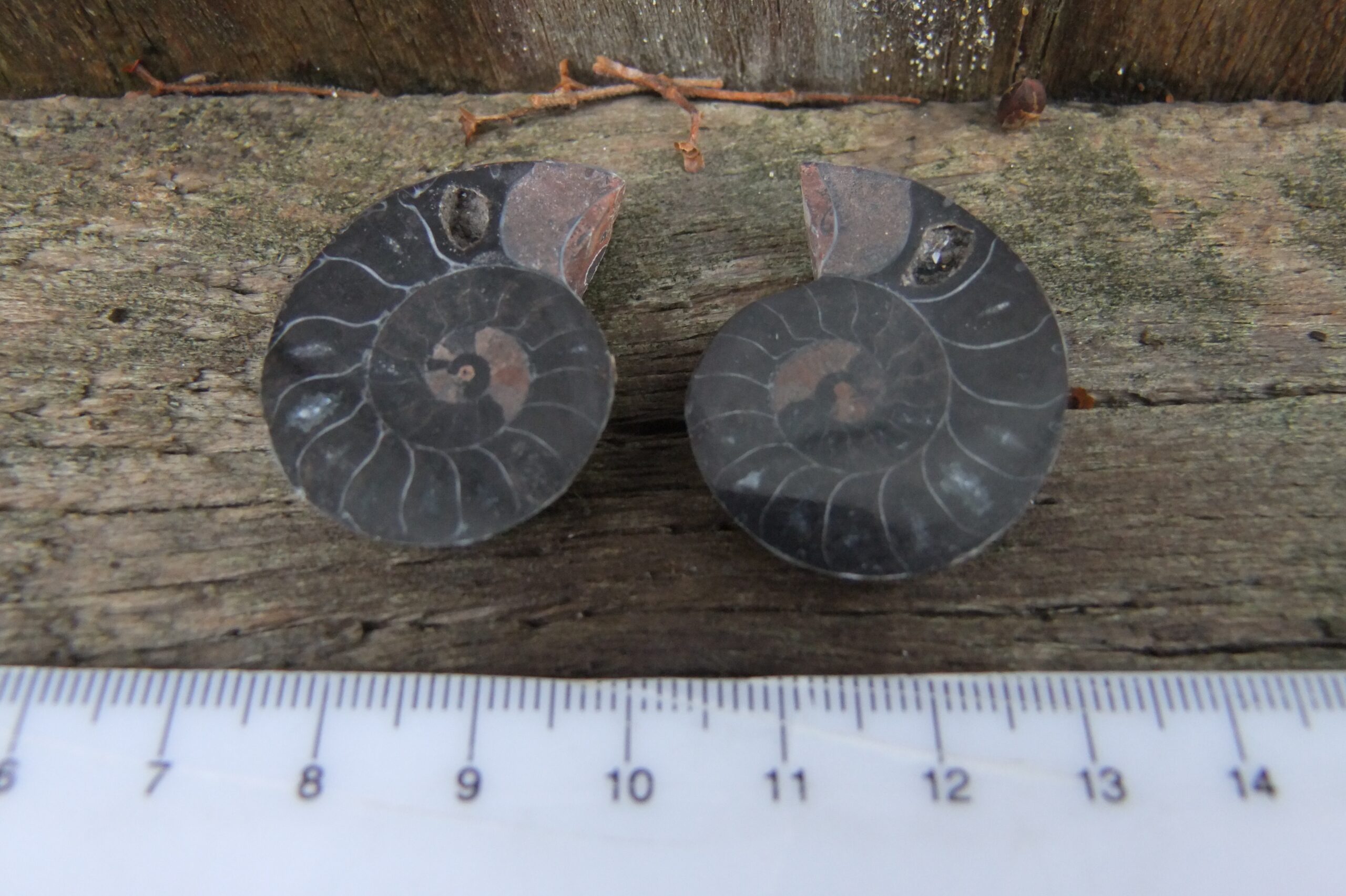Small Black Ammonite Pair
$ 10.00
Out of stock
Description
Small Black Ammonite Pair
3cm by 3.3cm by 1.4cm approx.
The Metaphysical Properties of Ammonites and Ammolite
Fossils are neglected in modern stone books but they are a potent union of the mineral and animal kingdoms. Metaphysical properties can be drawn both from their geology and biology and many were used for spiritual reasons historically.
What is an ammonite?
The Ammonoidea or ammonites (“am-uh-nights”) are an extinct group of shelled cephalopods that lived ~400 to ~65 million years ago. The name may specifically refer to one branch of them, the Ammonitida, that lived ~200 to ~65 million years ago. Their living relatives include the octopus, squid, and nautilus.
Ammonites lived in an external chambered shell, usually in the shape of a coiled spiral. Depending on the species, it could also be straight, partially bent, or corkscrewed. Their body was in the last and largest chamber. As they grew they added progressively bigger compartments to the mouth of their shell, walling off the old ones.
This chambered shell is called a phragmacone (“frah-muh-cone”), from the Greek phragmo, “fence, enclosure, partition”, + konos, “cone”. A thin organ called a siphuncle (“sigh-fung-kuhl”) connected each segment to the body chamber like a strand of beads. The word comes from the Latin sīphunculus, meaning “a little siphon”. They used this tube to maintain their buoyancy, regulating the mixture of water and gas in each compartment through their blood.
Ammonites may be found with a small curved shell called an aptychus (“ap-tea-cus”) or a symmetrically mirrored pair of them. The word comes from the Greekaptychon, “a folding panel with two parts”. There is debate among scientists if they were part of their jaw, a protective cover like the hood of a nautilus, or both. While ammonite shells were grown from aragonite, the aptychus was made from calcite. Although they are chemically related, calcite is more durable so many were preserved on their own, washed away from their shells. They were misidentified historically as a species of clam.
Although an incredible number of shells are preserved, very little soft tissue was fossilized. Therefore no one knows what an ammonite looked like exactly. Although their shells resemble a nautilus, their teeth are similar to the octopus and squid. So a spiral shelled animal with eight to ten tentacles is the best deduction.
What symbolism did ammonites have in antiquity?
The word ammonite references a historic name for the fossil. The first century CE Roman naturalist Pliny the Elder called them hammonis cornu, meaning “the horns of Ammon”. Ammon is the Latinized version of the name Amun, the ancient Egyptian god of creation, later interpreted as a form of Zeus by the Greeks. Amun was depicted as a ram, a man with the head or horns of a ram, or a ram headed sphinx. Pliny states:
“The horns of Ammon [“ammonite”] is reckoned among the most sacred gems of Aethiopia [“the upper region of the Nile”]; it is of a golden color, like a ram’s horn in shape, and ensures prophetic dreams, it is said.”
Do the historical lapidaries mention ammonites?
Many historical gem books include stones found in animals. Some actually come from living creatures like bezoars, mineral concretions produced in the digestive tract, while others have proven to be fossils. Most period “toadstones”, allegedly from the head of a toad, are instead teeth from the extinct fish species Lepidotes.
Likewise some scholars believe the legendary draconites, found in the head of a snake or dragon, could be an actual stone. Something with a resemblance, like the toadstone. Ammonites are a strong candidate since some draconites were described as displaying a serpent pattern. Depending on the text, it protected the wearer from poisons, venomous creatures, or adversaries.
Ammonites actually have a long association with serpents. According to English legend, the 7th century Saint Hilda of Whitby turned an infestation of snakes to stone to allow for the construction of an abbey. These petrified “snakestones” are ammonites. Sometimes artists would carve or paint a head on them, to produce pious souvenirs. English fossil hunters during the early 19th century called ammonites cornemonius, a corruption of their Latin name hammonis cornu.
Ammonites were used in folk medicine across Europe for snake bites, fertility, and birthing pains. In 18th century Germany and England they were added to water as “drakestones” (“dragonstone”) or “crampstones” to treat livestock.
What do ammonites mean in some Native American traditions?
To the Niitsitapi nation (“Blackfoot”), portions of ammonites, baculites, and other fossils are iniskim, meaning “buffalo stone, buffalo calling stone”. Baculites are a variety of ammonite with only a slightly bent shell. Fossil ammonites often come apart, breaking down into their individual chambers. Those with sutures become lobed, roughly resembling an animal, traditionally a buffalo. According to legend the first iniskim revealed itself during a famine to a young woman. It taught her the songs and ceremonies required to call the buffalo to be hunted. They reveal their presence by chirping like a bird and are associated with abundance, good luck, and healing.
What do ammonites represent in Hinduism?
Stones can have a special relationship to the divine in Hinduism, like the egg shaped linga of Shiva and the rounded black shaligram shila or salagram shila of Vishnu. Shila/Sila means “stone” in Sanskrit, shaligram/saligram is a regional name of Vishnu, and shalagram/salagram refers to a location where they are found. In Hindu thought God takes on different forms for the benefit of humanity. Vishnu is the divine as preserver. He is typically depicted as blue skinned, carrying a mace, lotus, conch shell, and a discus like weapon called a chakra.
The shila or salagram is a fossil concretion from the Gandaki River in Nepal, often with prominent ammonites. They are typically black in color but pyrite inclusions may make them golden. The fossil patterns are believed to represent sacred symbols like the attributes of Vishnu, especially his chakra. In mythology Vishnu transformed into vajra kita, aquatic worms as hard as diamonds, to carve them. An interpretation of the snake like ammonites found inside. The stones are traditionally used for devotion.
What do they mean in Chinese culture?
Some feng shui practitioners recommend ammonite and ammolite, an iridescent ammonite shell used as a gemstone, as wealth cures. Ammolite may be known by the trade name “kirin stone”, after the mythical Chinese composite animal, more commonly spelled qilin or ch’i-lin. They symbolize non-violence, virtue, and longevity. The iridescence of ammolite is said to resemble their fiery scales.19th century English texts say the Chinese call ammonites the “kosmos stone”, for its resemblance to their symbol for the cosmos. They mean its comma-like shape resembles the black and white sections of the taijitu (“yin and yang symbol”), especially as a pair. The spiral of an ammonite is believed to draw in chi (“spiritual energy”) and radiate it out, promoting abundance, health, and well being.
The Hidden Virtues of Ammonite
The metaphysical properties of a fossil are revealed in its geology, cultural associations, and effect on the chakra system:
1. Fossil: Because of their literal connection to the past, fossils support longevity, memory, and past life recall. They are also used to contact spirit guides, honor ancestors, or connect to ancient sources of knowledge. Ammonites are especially well suited for past life work since they are used as an index fossil. They help date the rock layers in which they are found because of their wide distribution, large numbers, and specific time span.
Ammonites only lived in the last chamber of their shell, using their phragmacone to stay afloat. Sometimes we are so focused on the future or the past, including our past lives, we neglect today. Use ammonites to regain perspective on the present, to integrate information about the past or potential future, or reorient after altered states of consciousness like shamanic journeying.
2. Shell: Because they come from the ocean, shells are connected to the Moon, water, and qualities culturally associated with the feminine like intuition, emotions, and the unconscious. Because ammonites are fossilized shells, they help transform the emotional past, releasing dysfunctional family patterns, childhood trauma, or suppressed feelings. Lunar materials are also associated with sleep, dreams, and techniques like lucid dreaming. This is especially true for ammonites since they were used historically for prophetic dreams.
3. Home: Both shells and materials ruled by the Moon symbolize the home. A lot of ammonite terminology is domestic: their shell is a phragmacone, Greek, “a cone of fences”, each chamber is a camera, Latin “a vaulted room”, and the dividers between them are septa, Latin, “walls”. Because of this architectural connection, ammonites are used for the spiritual protection of a house. Since the animal moved from chamber to chamber as it grew, walling off the old ones, they support individuals selling a home, in the process of moving, or adjusting to a new location.
4. Spiral: Both ammonite and nautilus shells are commonly used to illustrate the golden spiral, a growth pattern based on the Fibonnaci sequence with a ratio of 1.618. Unfortunately research suggests this is only rarely true. The nautilus is a logarithmic spiral but its average ratio is 1.33. Because these numbers are close, the inner chambers resemble the golden spiral but the outer ones deviate from it. While an individual shell may be a golden spiral, it is not true for all of them







